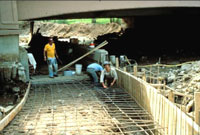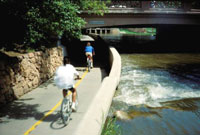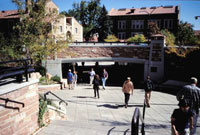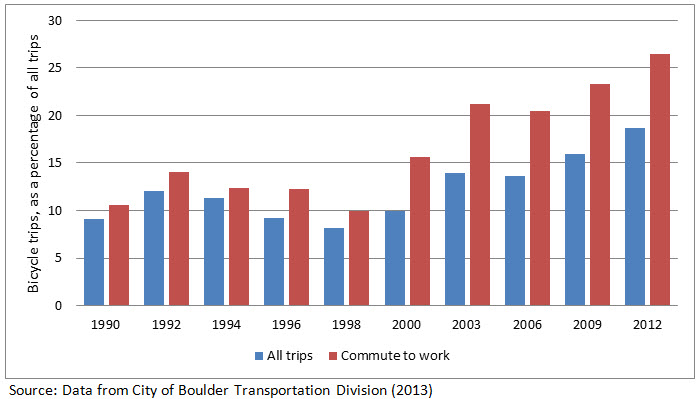Grade-Separated Crossing Treatments
Boulder, Colorado
Prepared by Cris Jones, Transportation Planner, Boulder, Colorado. 2014 updates by Krista Nordback and Jill Mead.
Background
The City of Boulder has always needed to accommodate flash floods. In 1910, Frederick Law Olmsted, Jr. warned the City of Boulder of the dangers of allowing development to encroach upon the floodplain of Boulder Creek. Recognizing the need to dedicate this floodplain land to a useful purpose, he suggested creating a space for public use.
With the goal of maintaining and enhancing the aesthetic and environmental integrity of Boulder Creek and its tributaries, the city adopted a "non-containment" policy for Boulder Creek as part of the Boulder Valley Comprehensive Plan in 1978. This policy promoted ongoing city efforts to protect public safety by restricting development within the floodplain of Boulder Creek and its tributaries. In 1984, the city adopted the Boulder Creek Corridor Plan that recommended the development of a continuous path along the entire length of Boulder Creek to serve as both a flood hazard mitigation measure and as a continuous urban park for recreational and transportation use. The construction of a continuous shared-use facility required the construction of separated grade crossings at each intersection throughout the corridor and existing creek underpasses were converted to include shared-use path underpasses through fairly simple modifications.

Construction of the Boulder Creek Path underpass at Broadway.
Countermeasures
Upon its completion, the Boulder Creek Path was instantly popular and quickly became a much loved community amenity. The public acclaim of the Boulder Creek project led to the extension of the concept to Boulder Creek's tributaries within the city. As a result, the Greenways Program has created stream corridors along fourteen tributaries of Boulder Creek.
Today, the City of Boulder is home to 75 underpasses built to provide grade-separated crossings for bicyclists on more than 300 miles of dedicated bikeways. While most new underpass projects have been driven by the transportation department, new underpasses along Boulder's greenways have increased flood carrying capacity and improved the natural environmental systems along Boulder Creek and its tributaries.

The completed Boulder Creek Path underpass at Broadway.
Although most underpasses have been built as a part of Boulder's greenway system, a number of underpasses have also been constructed at locations not along a waterway. These underpasses serve to eliminate pedestrian barriers and increase safety at dangerous intersections. The College and Broadway underpass, for instance, was designed with the sole purpose of increasing pedestrian safety.
Before construction of the College and Broadway underpass, thousands of students a day were forced to cross Broadway (U.S. Highway 92) at-grade, to get between campus and the University Hill commercial district. Students often crossed at midblock and would stand in the median before crossing entirely. Unlike most of the underpasses within the city, the Broadway and College underpass required a lengthy public process before construction. Merchants in the Hill commercial district worried that an unattractive or poorly designed underpass would be perceived as unsafe and discourage pedestrian traffic to their businesses. The city went through an extensive design process, including obtaining public input, and creating photo simulations of the proposed design to gain community acceptance.

Rendering of pedestrian underpass at College and Broadway used to create community support for the project.
Evaluation and Results
Boulder's network of bike paths and underpasses has increased the safety and convenience of bicycle and pedestrian travel, and in the case of the Greenways system, provided a continuous grade-separated system appropriate for users who are not comfortable using the on-street system. Barring rare events of motorists leaving the roadway, compared to on-street intersection locations, underpasses have practically zero risk of motorist-bicyclist collisions.
Annual counts collected by volunteers, and continuous counts collected using automated bicycle counters provide details about the growth of bicycling in Boulder over time. The graph shown in Figure 1 was created with data from automated counters at path locations and shows the growth of bicycling over time on the Greenways. The average number of bicyclists per day increased from 259 in 2004, to 461 in 2010, with a peak of 487 in 2008.
Figure 1: Number of bicyclists counted by automated bicycle counters at path locations




